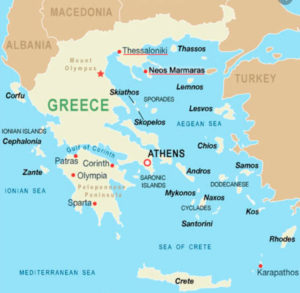 The history of the Jews in Greece can be traced back to at least the fourth century BCE. The oldest and the most characteristic Jewish group that has inhabited Greece are the Romaniotes. After their expulsion from Spain, between fifteen and twenty thousand Sephardic Jews settled in Thessaloniki. Greece became a haven of religious tolerance for Jews fleeing the Spanish Inquisition and other persecution in Europe. The Ottomans welcomed the Jews because they improved the economy and became known as a centre for commerce and learning. The exile of other Jewish communities swelled the city’s Jewish population, until Jews were the majority population in 1519.
The history of the Jews in Greece can be traced back to at least the fourth century BCE. The oldest and the most characteristic Jewish group that has inhabited Greece are the Romaniotes. After their expulsion from Spain, between fifteen and twenty thousand Sephardic Jews settled in Thessaloniki. Greece became a haven of religious tolerance for Jews fleeing the Spanish Inquisition and other persecution in Europe. The Ottomans welcomed the Jews because they improved the economy and became known as a centre for commerce and learning. The exile of other Jewish communities swelled the city’s Jewish population, until Jews were the majority population in 1519.
 Their presence, in Thessaloniki, was so significant that the thriving port was closed on the Jewish sabbath until World War I. Migration of Greeks from Asia Minor as part of the post-World War I population transfers with Turkey, along with political tensions within Greece, made many Greek Jews feel increasingly vulnerable in the decades before World War II. Prior to World War II over 70,000 Jews lived in Greece in 28 cities where well-organised and flourishing communities functioned.
Their presence, in Thessaloniki, was so significant that the thriving port was closed on the Jewish sabbath until World War I. Migration of Greeks from Asia Minor as part of the post-World War I population transfers with Turkey, along with political tensions within Greece, made many Greek Jews feel increasingly vulnerable in the decades before World War II. Prior to World War II over 70,000 Jews lived in Greece in 28 cities where well-organised and flourishing communities functioned.
There were three distinct Jewish communities: the Spanish speaking Sephardim living in the territories occupied by Greece after the Balkan Wars and the First World War; the Italian-speaking Corfiotes living in the Ionian Islands; and the Greek-speaking Romaniotes living mostly in Central and Southern Greece.
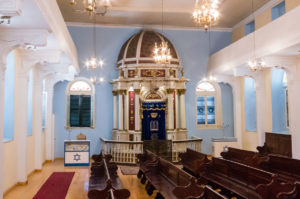 In 1934, a large number of Jews from Thessaloniki made aliyah to Mandatory Palestine, settling in Tel Aviv and Haifa. Those who could not get past British immigration restrictions simply came on tourist visas and disappeared into Tel Aviv’s Greek community. Among them were some 500 dockworkers and their families, who settled in Haifa to work at its newly constructed port. Until 1940, 80,000 Greek Jews enjoyed life in the knowledge that they were free citizens with equal rights and their Jewish way of life was still intact. They played a prominent role in the financial, social, political and intellectual life of the country and defended it patriotically in its hours of need.
In 1934, a large number of Jews from Thessaloniki made aliyah to Mandatory Palestine, settling in Tel Aviv and Haifa. Those who could not get past British immigration restrictions simply came on tourist visas and disappeared into Tel Aviv’s Greek community. Among them were some 500 dockworkers and their families, who settled in Haifa to work at its newly constructed port. Until 1940, 80,000 Greek Jews enjoyed life in the knowledge that they were free citizens with equal rights and their Jewish way of life was still intact. They played a prominent role in the financial, social, political and intellectual life of the country and defended it patriotically in its hours of need.
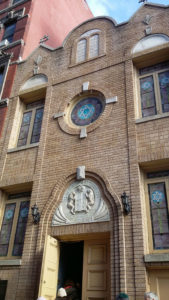 Their own dark hour came with the Nazi occupation. Despite all the efforts of the clergy, the state, the Resistance and the public at large, the Final Solution translated into 50,000 Jews being murdered in concentration camps. Though all communities suffered greatly, Greek Jews suffered even more because they were different and even when they reached Auschwitz, their suffering was even greater. Greek Jews were not used to the frigid climate of Eastern Europe and could not communicate with their fellow Jews from Eastern Europe, because they didn’t speak German, Yiddish, or Polish. Most of the 60 synagogues and schools in Greece were destroyed, along with the oldest Jewish cemetery.
Their own dark hour came with the Nazi occupation. Despite all the efforts of the clergy, the state, the Resistance and the public at large, the Final Solution translated into 50,000 Jews being murdered in concentration camps. Though all communities suffered greatly, Greek Jews suffered even more because they were different and even when they reached Auschwitz, their suffering was even greater. Greek Jews were not used to the frigid climate of Eastern Europe and could not communicate with their fellow Jews from Eastern Europe, because they didn’t speak German, Yiddish, or Polish. Most of the 60 synagogues and schools in Greece were destroyed, along with the oldest Jewish cemetery.
Losses were significant in places like Thessaloniki, Ioannina, Corfu and Rhodes, where most of the Jewish population were deported and killed. Larger percentages of Jews were able to survive, where the local population was helpful and hid the persecuted Jews, such as Athens, Larissa or Volos. Perhaps the most important rescue efforts took place in Athens, where some 1,200 Jews were given false identity cards following the efforts of Archbishop Damaskinos and police chief Angelos Ebert.
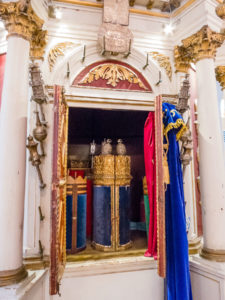 The 275 Jews of the island of Zakynthos, survived the Holocaust due to support from the island’s mayor, Karrer, and Bishop Chrysostomos of Zakynthos. The island’s population hid every member of the Jewish community. In 1947, a large number of the Jews of Zakynthos made aliyah to Palestine, while others moved to Athens. When the island was almost levelled by the great earthquake of 1953, the first relief came from Israel, with a message that read: “The Jews of Zakynthos have never forgotten their Mayor or their beloved Bishop and what they did for us.”
The 275 Jews of the island of Zakynthos, survived the Holocaust due to support from the island’s mayor, Karrer, and Bishop Chrysostomos of Zakynthos. The island’s population hid every member of the Jewish community. In 1947, a large number of the Jews of Zakynthos made aliyah to Palestine, while others moved to Athens. When the island was almost levelled by the great earthquake of 1953, the first relief came from Israel, with a message that read: “The Jews of Zakynthos have never forgotten their Mayor or their beloved Bishop and what they did for us.”
The city of Volos, was in the Italian zone of occupation, but when the Nazis took over, head rabbi Pessah worked with Archbishop Ioakim and the EAM resistance movement to find sanctuary for the Jews in Pelion. Due to their efforts, 74% of the city’s Jews were saved. However, due to emigtration, only 100 Jews remain in Volos today.
Though 10,000 Greek Jews survived the Holocaust, approximately 5,000 live in Greece today. They live in nine Jewish communities; those of Athens, Thessaloniki and Larissa being the largest and best organised, and those of Ioannina, Volos, Trikala, Chalkis, Corfu and Rhodes, each with fewer than 100 people.
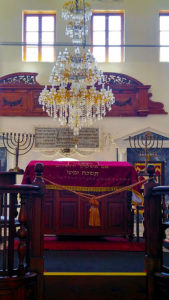 In 1944, Nazis put Chania’s Jews aboard a ship on the way to Auschwitz. Halfway to the mainland, the vessel Danae was hit by British torpedoes and sank. There were no survivors. Stavroulakis, whose parents left Chania before the war, is the only Greek Jew in Chania.
In 1944, Nazis put Chania’s Jews aboard a ship on the way to Auschwitz. Halfway to the mainland, the vessel Danae was hit by British torpedoes and sank. There were no survivors. Stavroulakis, whose parents left Chania before the war, is the only Greek Jew in Chania.
During his first visit, 13 years after World War II, he saw the Etz Hayyim synagogue in a pitiful state. Parts of it showed signs of bombing. Squatters lived there. The area had been used as a dog kennel, then a chicken coop. Broken furniture lay around the courtyard, full of weeds and garbage. The mikveh, the ritual bath, had been left as a sewer hole. From that day, he envisioned the restoration as a victory over the Nazi attempt to destroy the Jewish presence on Crete. He waged a single-handed drive to restore the 400-year old Synagogue as a remembrance of a community that stretches back nearly 2,400 years. In October 1999, Etz Hayyim was rededicated.
 Princess Alice of Battenberg, sheltered a Jewish widow and her two children in German-occupied Athens during the Second World War. She secretly ferried them food and messages of the war-torn outside world for 13 months. Princess Alice has been honoured by the Jewish people for saving a family from Nazi persecution despite the risks to her own family’s lives.
Princess Alice of Battenberg, sheltered a Jewish widow and her two children in German-occupied Athens during the Second World War. She secretly ferried them food and messages of the war-torn outside world for 13 months. Princess Alice has been honoured by the Jewish people for saving a family from Nazi persecution despite the risks to her own family’s lives.
At the end of the Second World War, Greek Christians, who had collaborated with the Germans and had looted and occupied their residences and businesses, refused to give them back. Communal properties of the Jews were quickly confiscated by the municipalities, Jewish tombstones were used to repair the streets and sidewalks, especially in Salonica. The efforts of the Jews to reclaim their personal properly often encountered a wall of reluctance on the part of the government. However, Greece was the first European country to return property confiscated during the war to its Jewish community, with a royal decree establishing a foundation for Jewish survivors and their heirs to present claims in court for restitution or compensation in 1949. Property of murdered victims was placed into a common fund to aid Greek Jews impoverished by the war.
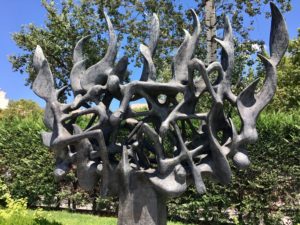 As of 2019, the Jewish community in Greece amounts to about 6,000 people, concentrated mainly in Athens, Thessalonika and Larissa, Volos, Chalkis, Ioannina, Trikala, Corfu, while very few remain in Kavala and Rhodes. The Jewish Community of Athens has two functioning synagogues. The older of two is the Romaniote one, the second one is Sephardi. Thessaloniki’s Jewish community has three synagogues. One of these is the renovated Monastir Synagogue that stands as a symbol of Thessaloniki’s strong former Jewish presence and has become a post-war symbol of the decimated community.
As of 2019, the Jewish community in Greece amounts to about 6,000 people, concentrated mainly in Athens, Thessalonika and Larissa, Volos, Chalkis, Ioannina, Trikala, Corfu, while very few remain in Kavala and Rhodes. The Jewish Community of Athens has two functioning synagogues. The older of two is the Romaniote one, the second one is Sephardi. Thessaloniki’s Jewish community has three synagogues. One of these is the renovated Monastir Synagogue that stands as a symbol of Thessaloniki’s strong former Jewish presence and has become a post-war symbol of the decimated community.
Kosher food is available in Greece and is most easily accessible in Athens and Thessaloniki. While few Jews remain in Rhodes, there is a Jewish quarter and a synagogue, Kahal Shalom, which also contains a small museum. There are a number of Jewish day schools available to Greek Jews mostly Athens, Thessaloniki, and Larissa.